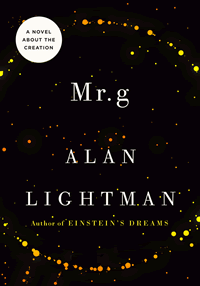A Complex Creation
In his new novel, Alan Lightman takes on the beginning of everything
Science and faith seem to be continually at war in American culture, with both sides claiming exclusive hold on the truth. In Mr g: A Novel About the Creation, Alan Lightman seeks to reconcile the two, respecting both reasoned inquiry and spiritual mystery. Lightman—physicist, poet, novelist, philanthropist and self-described “spiritual atheist”—retells the story of creation from the point of view of God (a.k.a. Mr g) and in the process delivers both a physics primer and a philosophical investigation of the roots of suffering and evil. His Mr g bridges the gap between the things we know and the things we cannot know.
The book opens with Mr g—and no, that lower-case g is not a typo, nor is the missing period after Mr—accompanied by his Uncle Deva and Aunt Penelope, languishing in the Void, a vast nothingness where time, space, and matter do not exist. This realm is, to say the least, a tad dull for Mr g and his kin. “Practically everything slept in an infinite torpor of potentiality,” he recalls—or rather, He recalls, since Mr g seems to be more or less identical with the singular deity of the Abrahamic tradition, and he is always granted the deferential capital in the text. Uncle Deva and Aunt Penelope are Lightman’s nod to non-Biblical cosmology. They represent a fundamental duality of male and female energy, and also serve as comic foils for Mr g. In order to relieve the tedium of the Void, Mr g decides to “replace nothingness with something,” and that something turns out to be time.
 Once discrete events are “enveloped in a slipcover of time,” things liven up considerably, and Mr g begins making things in earnest. He recounts his creation of his first universe with a combination of awe and geeky delight: “My universe had come into being! It was tiny at first, but beautiful, a lovely little sphere. Its surfaces were smooth and silky, yet infinitely strong. It glistened. It spun slightly. And it vibrated with energy.”
Once discrete events are “enveloped in a slipcover of time,” things liven up considerably, and Mr g begins making things in earnest. He recounts his creation of his first universe with a combination of awe and geeky delight: “My universe had come into being! It was tiny at first, but beautiful, a lovely little sphere. Its surfaces were smooth and silky, yet infinitely strong. It glistened. It spun slightly. And it vibrated with energy.”
Mr g creates innumerable universes before settling on a pet, designated Aalam-104729, which will be the site of the creation of matter and eventually of life, with all its attendant troubles. We get the first hint of that trouble with the sudden appearance in the Void of a mysterious stranger named Belhor, along with his monstrous sidekick Baphomet, both of whom are strangely beyond Mr g’s power to destroy. For the rest of the book, as Mr g confronts questions about consciousness, free will, morality, and mortality for his living creations, Belhor will be his antagonist, challenging him about his intentions and gently pushing him away from benevolent interference in the worlds he has made. This sparring continues until life in the special universe passes away. Agreeing with Aunt Penelope that Aalam-104729 was a ”lovely thing,” Mr g contemplates creating life anew in one of the multitude of other universes flying through the Void, “all waiting, and waiting.”
As in most of his previous work, from Einstein’s Dreams to Song of Two Worlds, Lightman is interested here in interrogating the mystery that resides where science and spirituality encounter one another. His creator speaks the language of science: he measures time in ticks of a hydrogen clock, and the name for his favorite universe includes the ten thousandth prime number in base ten. (“I won’t forget it,” he says.) His universe follows the physical laws he lays down, but even so, he is astonished when life creates itself from inanimate matter. He finds himself strangely moved by life’s blossoming consciousness, suddenly feeling “a sympathy toward the thing, even a tenderness.” And for all his vast power and intelligence, Mr g is severely challenged when Belhor confronts him with an argument for the necessity of evil.
 Lightman has always had a crystalline prose style, and it’s very much on display in Mr g. The passages devoted to existence in the Void and to the beauty of the developing universe are delightfully lyrical, even when they are filled with the gritty terminology of physics, as when Mr g describes the way neutrons and protons “flew about at a ferocious speed, surrounded always by an ultraviolet haze of soft gluons as they ricocheted off other frenetic nuggets of matter.” Lightman can be funny, as well, especially in the banter between Deva and Penelope, who bicker affectionately throughout the book. “I am married to someone with an amber sunset for a mind,” Penelope says at one point of her dreamy, slow-moving husband.
Lightman has always had a crystalline prose style, and it’s very much on display in Mr g. The passages devoted to existence in the Void and to the beauty of the developing universe are delightfully lyrical, even when they are filled with the gritty terminology of physics, as when Mr g describes the way neutrons and protons “flew about at a ferocious speed, surrounded always by an ultraviolet haze of soft gluons as they ricocheted off other frenetic nuggets of matter.” Lightman can be funny, as well, especially in the banter between Deva and Penelope, who bicker affectionately throughout the book. “I am married to someone with an amber sunset for a mind,” Penelope says at one point of her dreamy, slow-moving husband.
Lightman takes on the big metaphysical questions in his book with economy and clarity. Mr g’s debates with Belhor come across as natural dialogue between two bright minds, rather than stilted philosophizing. The narrative may bog down for some readers, however, in the passages devoted to the physical process of creation. Gracefully written, they still read like barely disguised lectures on physics and molecular biology. And some may take exception to the overwhelmingly male population of the Void. Lightman puts gender at the very core of existence, but then gives the feminine principle only a single voice, against five masculine ones. (Belhor gains a second demonic companion along the way.)
Quibbles aside, Mr g is a brilliant, entertaining allegory, a book that creationists and atheists would find equally thought-provoking. Lightman has created a novel that is erudite and fun to read, and more likely to inspire discussion than dispute.
Click here to read Chapter 16’s profile of Alan Lightman, and here to read an excerpt from his memoir in progress, Screening Room, about his Memphis childhood.


